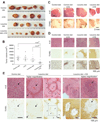Defective regulation of autophagy upon leucine deprivation reveals a targetable liability of human melanoma cells in vitro and in vivo
- PMID: 21575862
- PMCID: PMC3115736
- DOI: 10.1016/j.ccr.2011.03.012
Defective regulation of autophagy upon leucine deprivation reveals a targetable liability of human melanoma cells in vitro and in vivo
Abstract
Autophagy is of increasing interest as a target for cancer therapy. We find that leucine deprivation causes the caspase-dependent apoptotic death of melanoma cells because it fails to appropriately activate autophagy. Hyperactivation of the RAS-MEK pathway, which is common in melanoma, prevents leucine deprivation from inhibiting mTORC1, the main repressor of autophagy under nutrient-rich conditions. In an in vivo tumor xenograft model, the combination of a leucine-free diet and an autophagy inhibitor synergistically suppresses the growth of human melanoma tumors and triggers widespread apoptosis of the cancer cells. Together, our study represents proof of principle that anticancer effects can be obtained with a combination of autophagy inhibition and strategies to deprive tumors of leucine.
Copyright © 2011 Elsevier Inc. All rights reserved.
Figures







Comment in
-
Cancer: Autophagy presents Achilles heel in melanoma.Nat Rev Drug Discov. 2011 Jul 1;10(7):491. doi: 10.1038/nrd3482. Nat Rev Drug Discov. 2011. PMID: 21720400 No abstract available.
References
-
- Anthony TG, McDaniel BJ, Byerley RL, McGrath BC, Cavener DR, McNurlan MA, Wek RC. Preservation of liver protein synthesis during dietary leucine deprivation occurs at the expense of skeletal muscle mass in mice deleted for eIF2 kinase GCN2. J Biol Chem. 2004;279:36553–36561. - PubMed
-
- Berg JM, Tymoczko JL, Stryer L. Biochemistry. 6th ed. W.H.Freeman and Company; 2007.
Publication types
MeSH terms
Substances
Grants and funding
LinkOut - more resources
Full Text Sources
Other Literature Sources
Medical
Molecular Biology Databases
Research Materials

